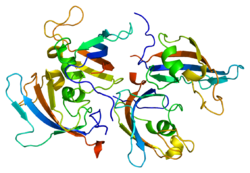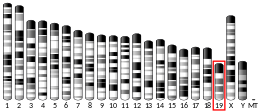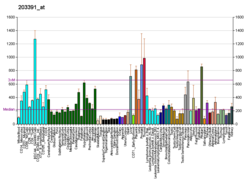| FKBP2 | |||||||||||||||||||||||||||||||||||||||||||||||||||
|---|---|---|---|---|---|---|---|---|---|---|---|---|---|---|---|---|---|---|---|---|---|---|---|---|---|---|---|---|---|---|---|---|---|---|---|---|---|---|---|---|---|---|---|---|---|---|---|---|---|---|---|
 | |||||||||||||||||||||||||||||||||||||||||||||||||||
| |||||||||||||||||||||||||||||||||||||||||||||||||||
| Identifiers | |||||||||||||||||||||||||||||||||||||||||||||||||||
| Aliases | FKBP2, FKBP-13, PPIase, FK506 binding protein 2, FKBP prolyl isomerase 2, FKBP13 | ||||||||||||||||||||||||||||||||||||||||||||||||||
| External IDs | OMIM: 186946 MGI: 95542 HomoloGene: 40604 GeneCards: FKBP2 | ||||||||||||||||||||||||||||||||||||||||||||||||||
| |||||||||||||||||||||||||||||||||||||||||||||||||||
| |||||||||||||||||||||||||||||||||||||||||||||||||||
| |||||||||||||||||||||||||||||||||||||||||||||||||||
| |||||||||||||||||||||||||||||||||||||||||||||||||||
| |||||||||||||||||||||||||||||||||||||||||||||||||||
| Wikidata | |||||||||||||||||||||||||||||||||||||||||||||||||||
| |||||||||||||||||||||||||||||||||||||||||||||||||||
FK506-binding protein 2 is a protein that in humans is encoded by the FKBP2 gene.[5][6]
Function
The protein encoded by this gene is a member of the immunophilin protein family, which play a role in immunoregulation and basic cellular processes involving protein folding and trafficking. This encoded protein is a cis-trans prolyl isomerase that binds the immunosuppressants FK506 and rapamycin. It is thought to function as an ER chaperone and may also act as a component of membrane cytoskeletal scaffolds. This gene has two alternatively spliced transcript variants that encode the same isoform. Multiple polyadenylation sites have been described for this gene, but the full length nature of this gene has not been determined.[6]
Interactions
FKBP2 has been shown to interact with ARFGEF1[7] and EPB41L2.[8]
References
- ^ a b c GRCh38: Ensembl release 89: ENSG00000173486 - Ensembl, May 2017
- ^ a b c GRCm38: Ensembl release 89: ENSMUSG00000056629 - Ensembl, May 2017
- ^ "Human PubMed Reference:". National Center for Biotechnology Information, U.S. National Library of Medicine.
- ^ "Mouse PubMed Reference:". National Center for Biotechnology Information, U.S. National Library of Medicine.
- ^ Jin YJ, Albers MW, Lane WS, Bierer BE, Schreiber SL, Burakoff SJ (Sep 1991). "Molecular cloning of a membrane-associated human FK506- and rapamycin-binding protein, FKBP-13". Proc. Natl. Acad. Sci. U.S.A. 88 (15): 6677–81. Bibcode:1991PNAS...88.6677J. doi:10.1073/pnas.88.15.6677. PMC 52151. PMID 1713687.
- ^ a b "Entrez Gene: FKBP2 FK506 binding protein 2, 13kDa".
- ^ Padilla PI, Chang MJ, Pacheco-Rodriguez G, Adamik R, Moss J, Vaughan M (Mar 2003). "Interaction of FK506-binding protein 13 with brefeldin A-inhibited guanine nucleotide-exchange protein 1 (BIG1): effects of FK506". Proc. Natl. Acad. Sci. U.S.A. 100 (5): 2322–7. Bibcode:2003PNAS..100.2322P. doi:10.1073/pnas.2628047100. PMC 151339. PMID 12606707.
- ^ Walensky LD, Gascard P, Fields ME, Blackshaw S, Conboy JG, Mohandas N, Snyder SH (Apr 1998). "The 13-kD FK506 binding protein, FKBP13, interacts with a novel homologue of the erythrocyte membrane cytoskeletal protein 4.1". J. Cell Biol. 141 (1): 143–53. doi:10.1083/jcb.141.1.143. PMC 2132710. PMID 9531554.
Further reading
- DiLella AG, Hawkins A, Craig RJ, Schreiber SL, Griffin CA (1992). "Chromosomal band assignments of the genes encoding human FKBP12 and FKBP13". Biochem. Biophys. Res. Commun. 189 (2): 819–23. doi:10.1016/0006-291X(92)92276-4. PMID 1281998.
- Hendrickson BA, Zhang W, Craig RJ, Jin YJ, Bierer BE, Burakoff S, DiLella AG (1993). "Structural organization of the genes encoding human and murine FK506-binding protein (FKBP) 13 and comparison to FKBP1". Gene. 134 (2): 271–5. doi:10.1016/0378-1119(93)90106-D. PMID 7505249.
- Bush KT, Hendrickson BA, Nigam SK (1994). "Induction of the FK506-binding protein, FKBP13, under conditions which misfold proteins in the endoplasmic reticulum". Biochem. J. 303 (Pt 3): 705–8. doi:10.1042/bj3030705. PMC 1137603. PMID 7526846.
- Nigam SK, Jin YJ, Jin MJ, Bush KT, Bierer BE, Burakoff SJ (1993). "Localization of the FK506-binding protein, FKBP 13, to the lumen of the endoplasmic reticulum". Biochem. J. 294 (Pt 2): 511–5. doi:10.1042/bj2940511. PMC 1134484. PMID 8373365.
- Walensky LD, Gascard P, Fields ME, Blackshaw S, Conboy JG, Mohandas N, Snyder SH (1998). "The 13-kD FK506 binding protein, FKBP13, interacts with a novel homologue of the erythrocyte membrane cytoskeletal protein 4.1". J. Cell Biol. 141 (1): 143–53. doi:10.1083/jcb.141.1.143. PMC 2132710. PMID 9531554.
- Padilla PI, Chang MJ, Pacheco-Rodriguez G, Adamik R, Moss J, Vaughan M (2003). "Interaction of FK506-binding protein 13 with brefeldin A-inhibited guanine nucleotide-exchange protein 1 (BIG1): effects of FK506". Proc. Natl. Acad. Sci. U.S.A. 100 (5): 2322–7. Bibcode:2003PNAS..100.2322P. doi:10.1073/pnas.2628047100. PMC 151339. PMID 12606707.
- Willingham S, Outeiro TF, DeVit MJ, Lindquist SL, Muchowski PJ (2003). "Yeast genes that enhance the toxicity of a mutant huntingtin fragment or alpha-synuclein". Science. 302 (5651): 1769–72. Bibcode:2003Sci...302.1769W. doi:10.1126/science.1090389. PMID 14657499. S2CID 43221047.
- Rual JF, Venkatesan K, Hao T, Hirozane-Kishikawa T, Dricot A, Li N, Berriz GF, Gibbons FD, Dreze M, Ayivi-Guedehoussou N, Klitgord N, Simon C, Boxem M, Milstein S, Rosenberg J, Goldberg DS, Zhang LV, Wong SL, Franklin G, Li S, Albala JS, Lim J, Fraughton C, Llamosas E, Cevik S, Bex C, Lamesch P, Sikorski RS, Vandenhaute J, Zoghbi HY, Smolyar A, Bosak S, Sequerra R, Doucette-Stamm L, Cusick ME, Hill DE, Roth FP, Vidal M (2005). "Towards a proteome-scale map of the human protein-protein interaction network". Nature. 437 (7062): 1173–8. Bibcode:2005Natur.437.1173R. doi:10.1038/nature04209. PMID 16189514. S2CID 4427026.
- Lim J, Hao T, Shaw C, Patel AJ, Szabó G, Rual JF, Fisk CJ, Li N, Smolyar A, Hill DE, Barabási AL, Vidal M, Zoghbi HY (2006). "A protein-protein interaction network for human inherited ataxias and disorders of Purkinje cell degeneration". Cell. 125 (4): 801–14. doi:10.1016/j.cell.2006.03.032. PMID 16713569. S2CID 13709685.






